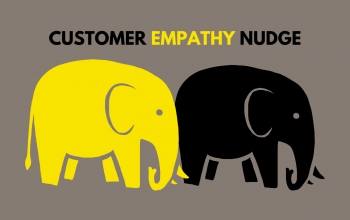
What does your team discuss in their daily stand-up?
This was a question I asked my LinkedIn connections this week.
Typically it’s:
1. What did you do yesterday?
2. What will you do today?
3. What is blocking progress?
On Tuesday, I had the pleasure of talking with Bill Staikos for his new podcast, Be Customer Led. Our discussion turned to Customer Experience (CX) Strategy, its importance, how to develop and how to operationalise.
I relayed the message from a recent how-to webinar on CX strategy. The ‘experts’ focus was putting customers first, but they failed to discuss the importance of customers’ needs / goals / expectations; only referencing this 3 times in the 45 minute session!
How often are we really discussing our customers’ needs in our daily stand-up meetings?
This got me thinking. How often are we really discussing our customers’ needs in our daily stand-up meetings, ELT meetings and project meetings, etc.? We know what we should be doing but how is this translating into enterprise wide, customer-centric behaviour; our small, day-to-day actions?
Customer Empathy Nudges
So I’d like to suggest a 4th point be added to daily meetings; a customer empathy nudge
1. What did you do yesterday?
2.What will you do today?
3. What is blocking progress?
AND
4. What would our customers think about that?
Simply put, customer empathy is understanding your customers’ point-of-view, feeling their experience and using their perspective in your thinking, problem solving and decision-making.
Customer empathy ‘nudges’ are used to boost how employees think, act and communicate
Customer empathy ‘nudges’ are used to boost how employees think, act and communicate. Nudges are small and subtle prompts that can inspire positive behavioural change in employees. By definition, empathy nudges should be easy and inexpensive to implement.
In order to develop an enterprise-wide, customer-centric mindset, leaders need to embed customer in their business’s day-to-day behaviour—employees need constant prompts to develop empathetic connection. There needs to be a shift from the business status quo to new practices that nudge changes in how things get done.
Asking ‘What Would Our Customers Think?’ or ‘How Would This Make Our Customers Feel?’
This simple question is a customer-centric game changer. All too often, conventional business-biased behaviours overwhelm the process of solving customer problems. This question is a decision making ritual that asks meeting participants around the table to step into the customer’s shoes and consider how their thinking or the team’s ideas will impact the customer’s experience.
Good customer nudge examples include: persona profile decals, a vacant chair that symbolises the customer in meetings, a customer ‘storytelling minute’ at the start of meetings, starting brainstorm sessions with customer empathy mapping and the like.
Empathy Nudge Case Study
To illustrate how nudge theory works, empathy expert Jamil Zaki, shared the following case study in his book, The War for Kindness.
As the AIDS epidemic worsened in the late 1980’s and early 1990’s so did the stigma attached to having the disease, with victims often blamed for their illness. Thousands of people were rapidly afflicted. “The victims were statistics, and strangers—two big reasons not to empathize.” Psychologist Dan Batson “… knew that people naturally care about single individuals and their stories. Could he leverage that to get them to empathise with a whole group?”
To test his theory he played a recording of a patient (Julie), describing the illness and her experience of living with AIDS, to a group of university students. “Sometimes I feel pretty good, but in the back of my mind it’s always there. Any day I could take a turn for the worse. And I know that—at least right now— there’s no escape … I feel like I was just starting to live, and now, instead I’m dying.”
Batson used the following empathy nudge to prompt a mindset change. He encouraged students to really listen to Julie and instructed them to imagine what this must feel like. “Unsurprisingly, this prompt increased people’s empathy for the patient. But, more important, participants who imagined how the patient felt also came to care more about other people living with HIV or AIDS.”
LinkedIn Comment Response Examples to the Question: “What does your team discuss in their daily stand-up?”
Bill Staikos: Alex Allwood, first you’re way too kind with the compliment; it was my sole pleasure to have you on the show. Second, I love #4 because it also drives action of understanding the customer perspective if the team’s response is, “We don’t know.” The beauty of the question is that one can always find out and use it to answer 1, 2, or 3 the next day! Third, who doesn’t love a nudge every now and again?!
Chris Cristoff: Would make a great addition to the Agile project management daily scrum standups, and for the sprint reviews and retrospectives, bringing in more a of customer focus on the planned activities and the outcomes
Rebecca Ryckman: This is such a simple suggestion to add to daily meetings but the impacts could be huge! I love this. Thanks for sharing.
Scott Lee: That is a great addition Alex; we might even want to consider having a customer representative in one of our zoom meetings.
Amanda Jones: In the old days (face to face meetings) we used to include a chair at the table to represent the customer. This is a great question and I am looking forward to your Masterclass next week Alex Allwood for more!
DON’T MISS MY NEXT MASTERCLASS: Using Customer Empathy to Unlock Customer-Centric Growth
Wednesday September 16th @ 4pm: https://alexallwood.com.au/unlock-growth/



